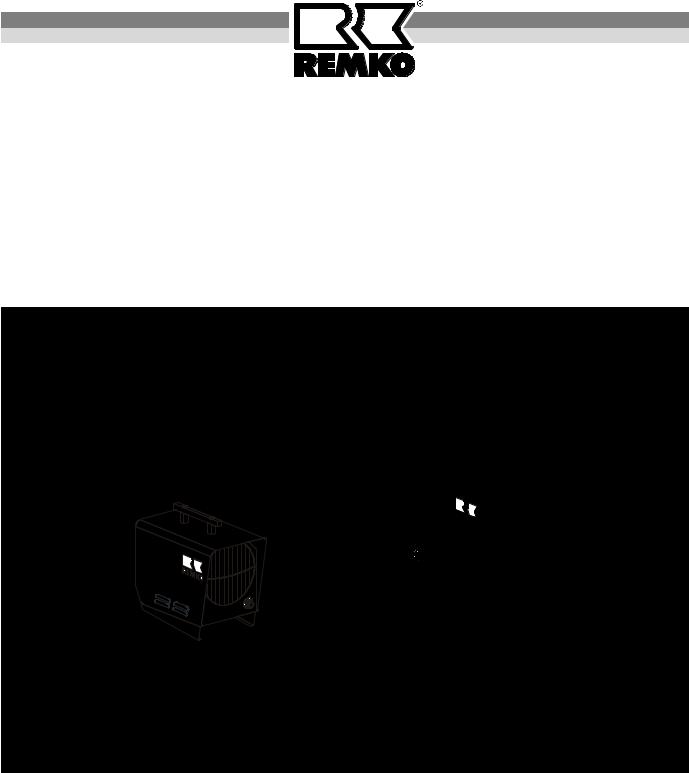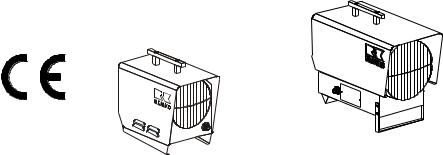REMKO PGM 30 User Manual

REMKO PGM 30 / 30 E REMKO PGM 60 / 60 E Propane gas heater
Operation
Technology
Spare Parts
Edition GB – R02 |
REMKO - powerful like a bear. |

Operating instructions
Read these instructions carefully before setting up/operating the unit!
Our guarantee becomes null and void if the unit is used, set up
or maintained improperly, or if modifications are made to the supplied unit without our prior consent.
Subject to alterations!
Mobile propane gas heater
REMKO PGM 30 / 30 E
REMKO PGM 60 / 60 E
Contents |
Page |
Contents |
Page |
Safety Instructions |
4 |
Technical Data |
9 |
Description of the Unit |
4 |
Wiring Diagram |
9 |
General Instructions |
5 |
Service and Guarantee |
9 |
Before Starting |
5 |
Exploded View PGM 30 / 30 E |
10 |
Gas Supply |
6 |
Spare Part List PGM 30 / 30 E |
11 |
Starting |
7 |
Exploded View PGM 60 / 60 E |
12 |
Safety Mechanism |
7 |
Spare Part List PGM 60 / 60 E |
13 |
Unit Shut Down |
8 |
Troubleshooting |
14 |
Maintenance |
8 |
Maintenance Log |
15 |
* Always keep these operating instructions near or on the unit! *
3

Safety Instructions
Make sure to observe relevant local building and fire protection codes and abide by professional association regulations when the unit is in operation.
Please also observe the following.
The unit may only be operated by persons who have received proper training in its operation.
The units must be installed and operated in such a way that people are not exposed to radiant heat and fires cannot occur.
The units may only be installed and operated in closed rooms where the units have an adequate air supply for combustion.
The portable liquid gas tanks must be set up securely in an upright position.
During unit operation, the portable liquid gas tanks may never be used while they are lying on their sides.
Danger of explosion: liquid gas may leak out of the gas nozzle.
The unit may only be operated in well-ventilated rooms.
Persons may not remain in the room where the unit has been installed for longer periods of time.
Warning signs must be placed at the entrances.
The unit may only be set up and operated on a nonflammable surface.
Make sure that no flammable objects/materials can be sucked in to the unit.
The unit may not be set up or operated in surroundings susceptible to fire or explosions.
A safe distance off 1.5 m must be maintained around the unit; a distance of 3 m must be maintained from its exhaust opening, even for nonflammable objects.
The unit’s exhaust opening may not be reduced in size or equipped with hoses or pipes.
Never insert foreign objects into the unit.
The air suction grille must always be kept free of dirt and loose objects.
Do not expose the unit to a direct stream of water.
All electric cables outside the unit are to be protected from damage (e.g. caused by animals, etc.).
Before performing any maintenance or repair work, make sure to unplug the unit from the power supply and disconnect it from the fuel supply.
*Do not bypass or block safety mechanisms while the unit is in operation.
Description of the Unit
The unit is a mobile, liquid gas-fired heater with a fan for transporting hot air. It does not have a heat-exchanger.
The unit works without an exhaust system and is only suitable for industrial purposes. The unit is a direct-fired device which has been designed for universal and smooth operation.
The unit is equipped with an integrated “power regulation“ function for gradual control of heat output, as well as with a durable flame burner, an electromagnetic valve, a piezo electric ignition, a safety pilot with thermoelectric flame monitoring, a connecting cable with plug and finally a quiet axial fan which requires little maintenance.
The unit meets the basic safety and health requirements found in the relevant EU regulations.
Areas of Application
The unit can be used, for example:
to dry new buildings
to provide localised heat for outdoor workplaces or localised heat in production rooms and halls not susceptible to fire.
to permanently or temporarily heat closed and open rooms that have sufficient fresh air intake
to de-ice machines, vehicles and non-flammable stored goods and regulate the temperature of components susceptible to frost.
*For optimum unit operation, the device should not be operated at an ambient temperature above 25 °C.
Unit Functionality
When the unit is switched on (operating switch set to "I" = heating mode), the air supply fan starts and the electromagnetic valve opens. However, the gas supply to the burner is still closed off.
The gas supply to the burner is released by pressing the pin of the thermoelectric gas valve (safety pilot). The liquid gas is supplied to the burner pipe through a pressurised nozzle where enough oxygen is added to meet the respective burner capacity.
The resulting gas-air-mixture is ignited on the burner head by an electric ignition spark. The spark is generated by manually triggering the piezo electric igniter.
Thermoelectric flame monitoring is started by heating the thermocouple. The safety pilot pin must now be released. If there are operational problems or the flame goes out, the gas supply is interrupted. However, the supply air fan continues running.
The safety temperature limiter (STB) interrupts the gas supply and locks all functions if the unit overheats. The STB can only be manually released after the unit has cooled.
The min/max heat output can be gradually with the “power regulation“ function during unit operation.
4

General Instructions
The unit may only be operated by persons who have received proper training in its operation and how to handle liquid gas.
When operating the unit, make sure to comply with the relevant national/regional guidelines.
The unit may only be operated in rooms
–with sufficient air supply for combustion
–that are well-ventilated
–where the quantities of substances which can be harmful when breathed in are admissible.
Good natural ventilation exists when, for example:
1.The room content in m³ equals 30 times the rated heat output of all units in operation in the room and natural ventilation is supplied through doors and windows or
2.There are non-closable openings for air output and intake close to the ceiling and floor whose size in m² equals at least 0.003 times the rated heat output in kW of all heating units in operation in the room.
A standard unit connection pressure of 1.5 bar (1500 mbar) of category I 3B/P is required for all EU countries.
The connection pressure may not fall below or exceed the required value.
When longer hoses are used, the corresponding pressure loss has to be taken into account.
Use only those parts, such as gas hoses, pressure controller and mechanisms which protect lines and hoses from breaking and safety mechanisms that prevent gas leakage, that have been tested and are suitable for the intended purpose.
The pressure controllers must have a fixed initial pressure of 1500 mbar and must be equipped with a mechanism that prevents the hose from breaking.
The unit may not be operated if the gas is in a liquid state as it enters the burner.
At building sites, only hoses designed for use with liquid gas may be used.
In accordance with regional regulations.
The length of the gas hose should not exceed 2 metres.
Longer hoses may be used if safety regulations are observed and the length of the hoses is kept as short as possible.
Gas hoses must be protected against chemical, thermal and mechanical damage.
If unit operation is unmonitored, hoses must be used that protected against breakage.
Prior to operating the unit, the operating personnel must check that the unit and its safety mechanisms are functioning properly and that the safety mechanisms have not been removed.
Any defects are to be reported to the supervisor immediately.
The unit must be switched off if any defects are found which endanger the safe operation of the unit!
The unit may be only serviced by authorised personnel; only original spare parts may be used.
Parts that wear out must be replaced on a regular basis unless an authorised service person confirms that the unit is functioning smoothly.
If the unit has been switched off by the temperature limiter due to overheating, the reason the problem occurred has to be identified and fixed.
If work is performed on the gas supply hose or if
*the gas cylinder is replaced, all stop valves must be closed and nothing which can potentially ignite may be present in the immediate surroundings.
Before Starting
Only individuals who have been sufficiently trained in the respective area may operate the units and monitor the containers and storage of the cylinders.
Make sure that the operator is aware of potential dangers when handling liquid gas.
Prior to operation, the operators must check the units’ operating and safety mechanisms for any visible defects and ensure that the safety mechanisms have not been removed.
Important Information
The unit may only be installed in well-ventilated rooms; it may not be installed in residential living rooms or similar spaces!
A constant unit connection pressure of 1.5 bar (1500 mbar) must be maintained even when the unit is in continuous operation.
If the unit is operated at a building site, only hoses designed for this purpose may be used.
Clean the gas supply hose thoroughly before operating the unit for the first time.
*For optimum unit operation, the device should not be operated at an ambient temperature above 25 °C.
5
